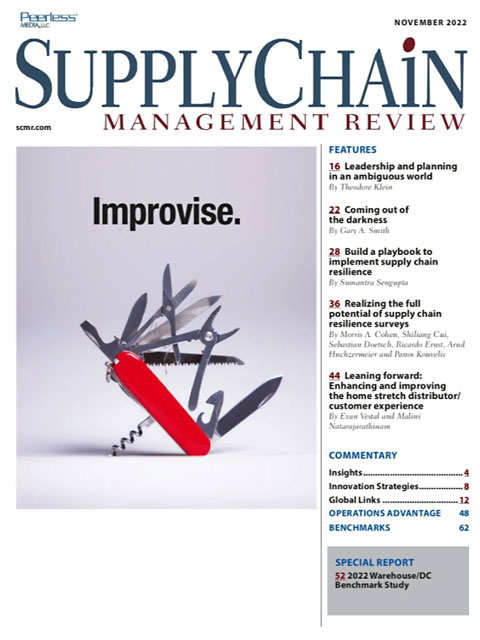Sorry, but your login has failed. Please recheck your login information and resubmit. If your subscription has expired, renew here.
November 2022
Are you resilient? It’s not an idle question. If there’s one word that I’ve heard at every supply chain event I’ve attended this year, its resilience. It is, of course, in response to the last few years in supply chain management. I think its fair to say that supply chains have been knocked to the canvas more times than Rocky. What has become clear as we do our post-pandemic reviews is that the firms that demonstrated the ability to get up off the canvas and keep punching were those that invested in resiliency before the pandemic—even if they didn’t use that term. Browse this issue archive.Need Help? Contact customer service 847-559-7581 More options
The July 2020 issue of SCMR featured my article, “Risk management in an era of extreme uncertainty.” The world had just woken up to the first quarter of the COVID-19 pandemic. Supply chains globally were disrupted and lead times from orders to delivery, or O2D, had suddenly grown by 50% in some cases. Ports were choked up and containers lined up awaiting their turn to be offloaded. Shelves for consumables in the United States were emptier than I had seen in 30 years. As the severity of the pandemic eased and the world began to unclog, we were faced with a new global issue—a senseless war in Ukraine coupled with global monetary policies that combined a delayed reaction with signs of an unexplained bull market.
In the United States, the consumer felt the pressures within weeks. The price of oil escalated around the globe as sanctions against Russia took hold. The price of gasoline increased 22% in April of 2022. Because Ukraine is a major producer of wheat, the impact on the price of food was felt as a lagging indicator. As if we didn’t need a reminder that unexpected disruptions continue to pop up, last September the United States narrowly averted a railroad strike that would have crippled domestic supply chains even further.
As companies rethink their supply chains to respond to instability, unpredictability and the unexpected, one factor is missing: A playbook, or a guide, that can be used to implement a structured approach to supply chain resilience. However, no two situations will be the same and hence companies need to think along the lines of the SCOR model for areas that are appropriate and can be modified to match future situations like the ones in play today.

This complete article is available to subscribers only.
Log in now for full access or start your PLUS+ subscription for instant access.
SC
MR
Sorry, but your login has failed. Please recheck your login information and resubmit. If your subscription has expired, renew here.
November 2022
Are you resilient? It’s not an idle question. If there’s one word that I’ve heard at every supply chain event I’ve attended this year, its resilience. It is, of course, in response to the last few years in… Browse this issue archive. Access your online digital edition. Download a PDF file of the November 2022 issue.The July 2020 issue of SCMR featured my article, “Risk management in an era of extreme uncertainty.” The world had just woken up to the first quarter of the COVID-19 pandemic. Supply chains globally were disrupted and lead times from orders to delivery, or O2D, had suddenly grown by 50% in some cases. Ports were choked up and containers lined up awaiting their turn to be offloaded. Shelves for consumables in the United States were emptier than I had seen in 30 years. As the severity of the pandemic eased and the world began to unclog, we were faced with a new global issue—a senseless war in Ukraine coupled with global monetary policies that combined a delayed reaction with signs of an unexplained bull market.
In the United States, the consumer felt the pressures within weeks. The price of oil escalated around the globe as sanctions against Russia took hold. The price of gasoline increased 22% in April of 2022. Because Ukraine is a major producer of wheat, the impact on the price of food was felt as a lagging indicator. As if we didn’t need a reminder that unexpected disruptions continue to pop up, last September the United States narrowly averted a railroad strike that would have crippled domestic supply chains even further.
As companies rethink their supply chains to respond to instability, unpredictability and the unexpected, one factor is missing: A playbook, or a guide, that can be used to implement a structured approach to supply chain resilience. However, no two situations will be the same and hence companies need to think along the lines of the SCOR model for areas that are appropriate and can be modified to match future situations like the ones in play today.
SC
MR


Latest Supply Chain News
- April manufacturing output slides after growing in March
- Q1 sees a solid finish with positive U.S.-bound import growth, notes S&P Global Market Intelligence
- World Trade Centers offers a helping hand to create resilient, interconnected supply chains
- 6 Questions With … Sandeep Bhide
- MIT CTL offering humanitarian logistics course
- More News
Latest Podcast

 Explore
Explore
Business Management News
- April manufacturing output slides after growing in March
- Q1 sees a solid finish with positive U.S.-bound import growth, notes S&P Global Market Intelligence
- 6 Questions With … Sandeep Bhide
- MIT CTL offering humanitarian logistics course
- Bridging the ESG gap in supply chain management: From ambition to action
- Few executives believe their supply chains can respond quickly to disruptions
- More Business Management
Latest Business Management Resources

Subscribe

Supply Chain Management Review delivers the best industry content.

Editors’ Picks






